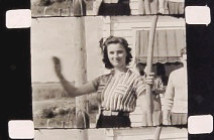Many sellers of original home movie materials in markets such as eBay proclaim as a selling point that the films are “Public Domain” (PD) — strongly suggesting that the winner of the auction will have full rights to exploit the material free of any copyright encumbrance. In the United States, this claim is simply false, due to provisions in the US 1976 Copyright Act, which removed the requirement that materials be registered in order to receive copyright protection. Home movies generally fall under the heading of “Unpublished Works,” and as such are automatically protected for a term 70 years after the death of the author. In the common instance where the maker of the film is unknown, the term is 120 years after creation — so as of 2014, only home movies shot by individuals who died before 1944 could be in the public domain. Otherwise, the heirs to the film material enjoy copyright ownership for some time to come. (Cornell University provides a handy guide to US Copyright)
Most home movies, therefore, will still be protected by copyright for many years, and are not in the public domain. Copyright is not automatically reassigned with sale or transfer of physical custody; it resides with the original creator or owner until they explicitly assign those rights to someone else. Practically speaking, however, in the case of orphaned, unidentified home movies, the old adage that “possession is nine-tenths of the law” could probably be stretched to 99-100th’s,because it is so unlikely that the re-use of such footage would be noticed or challenged by someone with a valid and verifiable claim of ownership. This means that home movies may be re-used in new projects in relative safety; even so, documentarians who wish to use orphaned home movie materials may encounter objections from legal counsel or clearance specialists who prefer to have evidence of explicit rights clearance, which may be impossible to acquire. Conducting due diligence—which might include researching the source of the footage and trying to identify and reach out to possible owners, creators, or their potential heirs, and carefully documenting any such efforts—helps minimize the risk of using orphaned material without clearance. (The Center for Media and Social Impact created a Best Practices in Fair Use statement for documentary filmmakers in 2005, which includes additional guidance on use of copyrighted material.)
The risk of copyright infringement is not the only consideration for users of home movie footage. Individuals who appear in the films — either as active participants or bystanders—have rights of personal privacy and publicity that should be weighed as well. Someone whose likeness is used in the endorsement or promotion of products or services may have reasonable objections to that use, and may pursue legal action that is not dependent on their having any copyright claim to the material. In the U.S., rights of privacy are only applicable during one’s lifetime, so using 50-year-old footage of elderly people is less risky than scenes of children or young adults, but privacy protection differs in other countries. Filmmakers should always carefully consider whether their use of the scenes with recognizable individuals might be objectionable, especially when the work endorses a particular product or addresses controversial topics.

